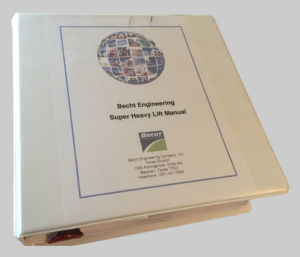Joe Collins of Becht Engineering explains the elements of a super heavy lift execution manual.
If you are making a single or series of super lifts, there will be a tremendous number of documents created during the planning stages. In addition to the original documents, there will be numerous revisions that fine tune the details. Controlling the document process can be overwhelming, but it is critical to your success. Why? Because there is a risk that the field crews may not have the most current revision when they attempt the lift. That omission could end in disaster.
There is no one definition for a “Super Lift” in any current standard. However, many companies performing extreme lifts within their facilities have coined the term and created their own definitions. The goal is to minimize risk by requiring a comprehensive engineered lift plan followed by a third-party review of the plan.
Although definitions may vary between companies, all are intended to achieve the same result – a safe lift. This system of checks and balances has proven value, and it has resulted in the safe lifting of massive objects worldwide. An accident with these heavy loads and giant cranes would be catastrophic – to human life, equipment, and the facilities.
The most difficult part of the lift planning process is Document Control – revising and distributing approved changes to the plan and ensuring field crews work from the most current plan. Becht Engineering Heavy Lift Division not only provides engineering reviews of Super Heavy Lift Plans, but it also builds a heavy lift manual called the “Lift Book” to document each review.
The success of the lift book is dependent on assigning a qualified and competent person to “own it” — someone totally responsible for maintaining it. This includes assuring the updates replace the preceding document immediately upon approval by the lift planning authority or third party reviewer.
Below is a summary listing that Becht Engineering includes in a Super Lift Manual or Lift Book. By design, the book is comprehensive and sometimes becomes very large, occupying several thick binders. A printed version of the lift book should be kept up to date, and one digital copy should be saved.
Section One – Overview
This section of the lift book should contain the Project Overview, including a description of the load and lift procedure followed by the Table of Contents (TOC).
The owner’s lifting policy should be included, along with any applicable crane policies from the various contractors. It is essential to verify and communicate the policies and procedures to all parties involved with the lift. These are the “house rules” and should be followed closely.
Section Two – Organization
This area of the manual should contain the organizational charts and contact information for the responsible persons from all participating companies. It should be followed with the personnel qualifications including the riggers, crane operators, assembly/disassembly director, lift director, and field supervisors, as well as for all persons involved with executing the lift crane assembly and lifting operations.
There are regulatory requirements associated with all these personnel, and Becht Engineering recommends becoming familiar with each one.
All technical information should be reviewed carefully and approved by a heavy lift professional prior to being inserted into the lift book. The subsequent sections can be assembled into the following classifications but do not necessary need to be in any specific order. Becht tends to organize the technical information according to the order of planning phases.
Section Three – Civil Engineering
Elements include:
- Geotechnical Report
- Site Survey
- Manufacturers Crane Ground Pressure Reactions
- Load Distribution Plans (such as matting and or soil improvements)
- Underground Structures (fire water, piping, electrical utilities)
Consult a geotechnical engineer to establish the allowable ground-bearing capacity of the unimproved soils where the equipment will be erected and operated. Given that information, the crane contractor is able to apply the crane ground bearing reactions and develop a matting plan to distribute the loads safely into the ground. Should standard matting be insufficient to properly distribute the loads, the geotechnical engineer can make recommendations for soil improvements. All underground utilities and/or structures are considered and analyzed for the ability to withstand the applied loads. Becht recommends a ground penetrating radar examination to locate any underground voids or abandoned structures that could collapse and affect the stability of the crane.
Section Four – Rigging Engineering
Elements include:
- Crane Configuration and Capacity Documents
- Crane Lift Plan and Rigging Drawings
- Material Take-Offs and Load Weight Calculations
- Rigging Certifications and Load Test Certificates
- Wind Speed Limits
- Rigging Points of Attachment
- Calculations for Lifting Lugs or Trunnions
- Non-Destructive Examination Reports
The crane capacity, configuration, load path and clearances to any obstacles must be determined and recorded into the lift plan. This section includes clearances of the crane’s lower works, crane counterweights, crane boom and load. The rigging must be thoroughly checked for capacity and stability of the load. It is important that all rigging configurations meet applicable codes and are proof tested prior to use. Record those diagrams and calculations in this section. All points of attachment for the rigging (lifting lugs, lifting eyes, and trunnions) must be analyzed for capacity to ensure they will not cause structural damage to the load. This analysis is followed by non-destructive examination in the field.
Section Five – Crane Assembly and Disassembly Plans
Elements include:
- Crane Manufacturers Detailed Assembly Instructions
- Detailed Crane Erection Procedure including elevation and Plan View Drawings
- Assembly Crane Configuration, Capacity Charts
- Assembly Crane Ground Bearing Pressure Mitigation Plans
- Plan for Personnel to Access Elevated Work
A detailed crane assembly plan then is developed. The plan includes where and how the crane will be assembled. Some large crane components become critical lifts due to their extreme weight. The clearances to facilities, control rooms, and any hazards must be identified and risk mitigated. Even the ground-bearing pressure of the assembly crane must be checked and proper matting installed.
Becht has utilized assist cranes of 600- to 800-ton capacity. Each crane component is carefully inspected before it is installed on the crane, and the complete crane is inspected before raising the boom. This inspection includes all assist cranes, the main crane(s), and tailing cranes.
Section Six – Crane Inspection Records
Elements include:
- Annual Inspection Records (three years)
- Daily Inspection Forms (insert completed forms into this section)
- NDE Reports for Hook Blocks
- Crane Maintenance Records (three years)
- Repair Summary (one year)
- Spare Parts List (recommended)
Section Seven – Risk Assessment
Elements include:
- Safety Execution Plan/Population Control Plan
- Contingency Plans
- For Operating Units
- For Evacuation of Crane/Rigging Personnel
- Incident Notification Plan
- Job Safety Analysis
A plan must be developed for managing the population of people working (and viewing) in the lift zone. Big lifts tend to draw onlookers who may wander into potentially dangerous areas.
Becht Engineering highly recommends development of Emergency Contingency Plans. These are intended to identify and assign responsibility to the crane and plant staff in the event of an emergency or accident.
If a plant emergency alarms during a lift the crane crew must be informed on what they will do regarding evacuation, stabilizing the load, etc. This plan must be communicated in advance and a plant authority stay with the crew to give instructions.
In the event there was a dropped load, collapsed boom, or something that disabled any part of the plant, the contingency must include an action plan to manually shut down the unit or plant. Then there is always the risk of losing power to critical equipment. The contingency plan also should include the procedures for crane management in the event of severe weather or high winds – both when the crane is in and out of service.
Section Eight – Forms
Elements include:
- FAA Permit
- Daily Work Permit Forms
- Hot Work Forms
- Personnel Basket Forms
Contact the Federal Aviation Administration if required!
The FAA requires and issues permits for all booms 200 feet high and above. They require notification should your work be near an airport, even if the boom is shorter than 200 feet – or if the airport is small. The permits are inexpensive but take time to obtain. The fines for operating without the permit are expensive (and we do not need to discuss the ramifications of an aircraft-to-crane collision). Allow a reasonable timeframe to obtain the permits as it could delay your project.
Wrapping Up
This information above outlines recommendations for the minimum items that should be included in a lift book. Your situation may demand additional documentation of special circumstances or requirements, which should be included. An example could be a transportation plan in the event that the loads must be delivered to the crane hook before or during lift time. In some cases, you may need a derigging plan if the rigging is not accessible by normal methods.
In the event of an unplanned event that results in a personal injury or damages assets, the lift manual should be able demonstrate due diligence (retrospectively) on the part of the owner and all parties responsible for the lift.
A comprehensive and carefully executed lift manual is well worth the effort and cost. It ensures all crane crews are using uniformly correct information and drawings. This is the next level of critical lift planning. After a successful and safe super heavy lift, a celebratory toast is warranted!
Joe Collins has 40 years experience in the heavy lift industry, with 20 of those years as manager of Zachry Construction Corporation’s crane fleet and lift operations. He is currently serving as vice president of the board of directors for the National Commission for the Certification of Crane Operators (NCCCO), an independent, not-for-profit organization established in 1995 to administer a nationwide program for the certification of crane operators. Joe also served as a member of the Cranes and Derrick Advisory Committee (C-DAC) to OSHA, which wrote and delivered the current draft of the new OSHA Crane Safety Standard. In January 2011, Engineering News-Record magazine honored Joe as one of the “Top 25 Newsmakers” for his work with C-DAC.




